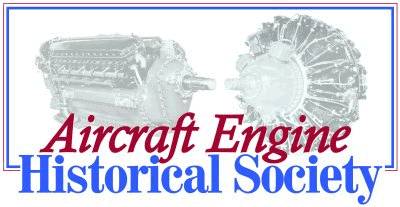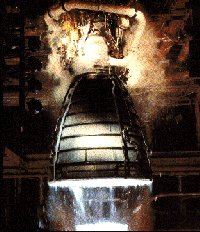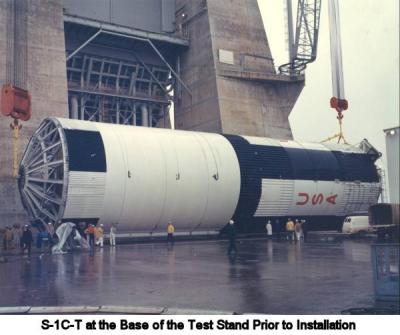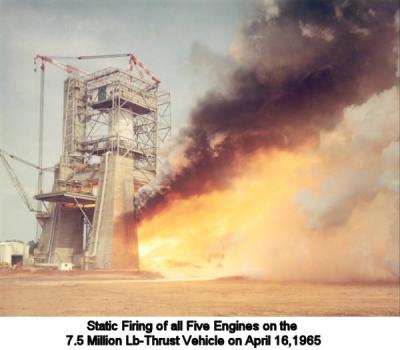|
|
 |
 |
|
 |
Rocket engines are the most extreme examples of power sources for things that fly. The history of rocket engine development is filled with the most incredible stories of engineering dedication and skill. It is also filled with stories of spectacular failures and even more spectacular successes. Most failures left only ions for evidence, making the job of development all the harder. The successes, especially those that took humans away from the planet for the first time, still inspire awe more than 50 years later. |
U.S. Manned Rocket Propulsion Evolution
at the U.S. Space & Rocket Center
F-1 Rocket Engine Combustion Instability Fix
Ad Astra per Aspera (To the Stars Through Hardships), by Terry Spath
NMUSAF Rocket Tour Docent Training, by Jeff Robeson (2.0M PDF)
 |
Titan II LR87 Rocket Engine Images |
Space Shuttle Main Engine
The First Ten Years
by Robert E. Biggs
One of the greatest engine development stories ever told is that of the Space Shuttle Main Engine. Through the generosity of of the American Astronautical Society and Univelt Inc. Publishers, Robert Biggs' landmark paper (AAS 89-556) is reproduced in its entirety. Biggs was at that time the Rocketdyne SSME project engineer.
When the Society of Automotive Engineers sought the greatest engineering achievement of the 20th Century, Karl Ludvigsen nominated the "invention and perfection of the liquid-fueled rocket as a means of navigation and transportation outside the earth's atmosphere." An excerpt from his submission appears below.
Please describe the engineering innovations that led to the achievement.
The innovations that were essential to this achievement included the development of light and efficient means of pumping liquid fuels, the chemical optimization of fuel combinations and the storage of cryogenic fuels, the cooling of the combustion chamber, the invention of internal guidance and control systems for autonomous rockets, the perfection of long-range radio guidance and control of deep-space probes, the invention of light-weight self-supporting rocket structures to reduce dead weight and improve performance, the development of techniques for achieving rendezvous in space and the implementation of a zero-defects approach to the engineering of a complete system.
Please provide a compelling case for why and how this engineering achievement has had a significant impact on society in the 20th Century.
Initially perfected for military purposes, this technology was married with the atomic bomb to place nations in a stance of mutual armed deterrence. The absence of a true defense against the ICBM with its A-bomb warhead obliged leading nations to find a way to disarm, thus ending the era of the atomic threat in the Northern Hemisphere.
Earth-orbit satellites launched by liquid-propellant rockets provide many benefits to mankind. They allow unprecedented accuracy of weather forecasting and especially the detection of dangerous storms. They have greatly refined the precision of the mapping of the earth. They provide a secure and reliable means of navigation and geographic location. They facilitate international communication by television, radio and telephony and offer alternate channels of communication to earthly TV receivers. They help improve the environment by allowing scrutiny from space of forests, lakes and rivers. They are being used to disclose the characteristics not only of our solar system but also of our cosmos, helping to bring closer the answer to the question that mankind has always asked: Why are we here?
In 1923 at the age of 29 a brilliant physics graduate, Hermann Oberth, published a dissertation in Munich that set out in detail the preconditions for travel outside the atmosphere. This accessible and inspiring work laid the foundations for the practical efforts of later researchers.
In the United States Robert Goddard first patented elements of liquid-fueled rockets in 1914 and in 1919 wrote A Method of Reaching Extreme Altitudes, setting out the principles of space flight. On 16 March 1926 he was the first in the world to launch a successful liquid-fueled rocket. Goddard's subsequent research to 1945 embraced all elements of liquid-fueled rockets including fuel delivery by pumps.
The first flight in Europe of a liquid-propellant rocket was near Dessau on 14 March 1931. In 1932 Wernher von Braun began experimenting with rocket engines for his doctoral dissertation. Under Army auspices Von Braun and his colleagues built progressively larger warhead-carrying rockets and on 3 October 1942 achieved the first successful flight of a large autonomous liquid-fueled rocket. It exceeded the speed of sound and left the earth's atmosphere.
In both America and Russia engineers built on the success of the von Braun-led technology to design and test larger liquid-fueled rockets. In the US this culminated in the Saturn V for the successful moon missions, a von Braun program, and in Russia in the versatile R-7 core launcher used both for an ICBM and for numerous peacetime space missions. It was developed by Sergei Pavlovich Korolev, who supervised the launch of Russia's first liquid-fueled rocket on 17 August 1933.
Many other engineers have contributed to the success of liquid-fueled rocketry in opening up the near regions of the cosmos to humankind. A particular contribution was that of Edwin E. 'Buzz' Aldrin, Jr., who pioneered in the planning and implementation of near-earth rendezvous techniques. Mr. Aldrin was the second person to walk on the moon on the evening of Sunday, 20 July 1969.
The Life and Times of Harry M. Johnstone
Johnstone was, until his retirement in 1979, an engineer with the NASA Marshall Space Flight Center, whose career spanned the development of launch vehicles from the Redstone to the Space Shuttle. These articles also appear in a book called 50 Years of Rockets & Spacecraft.
Part 1 -- Early 1950s. The Test Laboratory of the U.S. Army Ordnance Missile Laboratory
Part 2 -- Mid 1950s. The Test Laboratory of the U.S. Army Ordnance Missile Laboratory
Part 3 -- 1960 - 1963. Test Laboratory - NASA
Part 4 -- 1964-1966. Test Laboratory - NASA
In 1964 Karl Heimburg assigned me as Test Director to be responsible for the static firing operations in the West test area for the five-engine (F-1) cluster S-1C-T. The S-1C was the first stage of the Saturn V launch vehicle that put man on the moon. The S-1C was the largest booster in the world at that time with 7.5 million lbs of thrust. We thought the Saturn I was huge, but when we went to Manufacturing Laboratory and stood beside this monster, it was awesome.
Orville Driver, Bob Saidla and Bob Pride were responsible for the construction and activation of the S-1C Facility. Joe Lundy, John Funkhouser, Ron Tepool, Jan Monk and Al Dawly were responsible for the engine systems installation, checkout and operations. Tom Shaner, Carl Fuller, John Odom and Fred Cunningham were support engineers. Ferrieo, Henry, Coleman Corry, Bob Christian, McMahan, Harris, Bobby Cain and Hall were Instrumentation. Cates, Lindsey, Maples, Kliner Strange and Copeland were Electronics and Control.
The vehicle, less the engines and suction ducts, was received at the test stand on March 1, 1965. A 11.5 million lb load test utilized five 2.5 million lb hydraulic jacks to proof test the thrust structure. We installed flak curtains between engines to prevent shrapnel from damaging the adjacent engine in the event of an engine explosion. All of the electrical and instrumentation systems were connected and checked out.
 |
The S-II Program at the Mississippi Test Facility (MTF), operated by North American Rockwell, was simultaneously activating their facility to test the second stage of the Saturn V moon rocket. Dr. Wernher Von Braun would visit me several times on the S-1C test stand and ask me if we could beat their firing date. I said, "Yes." I’ll never forget the first time I met Dr. Von Braun. It was in a meeting where I was an underling. However, several months later he passed by my office and stuck his head into the door and said, "Hello Harry." This was remarkable that he would remember my name. This man radiated with charisma and he became my hero. Our initial schedule to static fire was June 15, 1965, however we managed to accelerate our program by a great team effort, installed five engines, and fired a single engine F-1 at the center position April 9, 1965 — 9 weeks ahead of schedule. Once again, we performed the first test 40 days after installing the vehicle in the test stand. Cutoff was given by an observer inadvertently. We recycled the count and fired two and one-half hours later. Cutoff this time was given by main fuel valve No. 1 safety circuit which indicated the valve closed, but actually the valve was open. After the test, we found four of the eight bolts for the engine gimbal block to thrust structure were broken. Bolts of the wrong material had used. One more broken bolt and we possibly could have had a catastrophic situation if the F-1 engine had fallen from the vehicle. A fire and an explosion would have followed. We static fired all five engines on the 7.5 million lb-thrust vehicle, the largest in the world, on April 16,1965, two months ahead of schedule. One more "most exciting day of my life." |
 |
What a blessing it was to live in that exciting time. Each engine weighed nine tons (45 tons for all 5), total flow of LOX for five engines is 125,190 gal/min and total flow of fuel (RP-1) is 78,160 gal/min. It is really hard for me to comprehend this flow rate. This vehicle placed 232,000 lb (116 tons) in orbit. However, after the last Saturn launch, the government scrapped the whole program. I served on many study committees later where we wished that we had the Saturn vehicle to go back to the moon or to Mars. I give thanks and praise to the greatest test team in the world in meeting this great milestone. Dr Von Braun was elated. I organized a social as a celebration, a dinner-dance which Dr. Von Braun attended. Ron Tepool was presented the "cutoff" button that he had used to cutoff the first test. Ron was involved in the F-1 single engine testing at the STTW. The F-1 started very slow with huge bellows of black smoke flowing out of the thrust chamber surrounding the engine as if it was on fire. We dissipated this black smoke with a large volume thrust chamber exit gaseous nitrogen purge. On the S-1C-T test, we did not use the purge, the whole engine area was black and red as if on fire and Ron excitedly cutoff the test. Later, he told us he was sorry. Dr. Von Braun took Ron around after dinner and introduced him as the man with the "Gold Finger". Dr. Von Braun sent me a personal letter of appreciation, recognizing that it took a great team effort and congratulating the entire team. I still treasure this personal letter today. I had a dream team behind me and there was no way that we would not succeed. My team gave their heart and soul to the program, working long, stressful and sometimes dangerous hours. I might add here that in motivating my engineers and technicians, we would stack hands on a table one on top of another drawing the conclusion that that we were all one together with the single purpose to meet our goal. Our saying was "this job ain’t no hill for a stepper." There was an air of confidence about our whole team. After 15 successful static firings, the S-1C-T was transported by barge to MTF in the spring of 1966 for check out of their newly constructed test facility. |